If the stars hadn’t aligned, two of the most remarkable spacecraft ever launched never would have gotten off the ground. In this case, the stars were actually planets—the four largest in the solar system. Some 60 years ago they were slowly wheeling into an array that had last occurred during the presidency of Thomas Jefferson in the early years of the 19th century. For a while the rare planetary set piece unfolded largely unnoticed. The first person to call attention to it was an aeronautics doctoral student at the California Institute of Technology named Gary Flandro.
It was 1965, and the era of space exploration was barely underway—the Soviet Union had launched Sputnik 1, the first artificial satellite, only eight years earlier. Flandro, who was working part-time at NASA’s Jet Propulsion Laboratory in Pasadena, Calif., had been tasked with finding the most efficient way to send a space probe to Jupiter or perhaps even out to Saturn, Uranus or Neptune. Using a favorite precision tool of 20th-century engineers—a pencil—he charted the orbital paths of those giant planets and discovered something intriguing: in the late 1970s and early 1980s, all four would be strung like pearls on a celestial necklace in a long arc with Earth.
This coincidence meant that a space vehicle could get a speed boost from the gravitational pull of each giant planet it passed, as if being tugged along by an invisible cord that snapped at the last second, flinging the probe on its way. Flandro calculated that the repeated gravity assists, as they are called, would cut the flight time between Earth and Neptune from 30 years to 12. There was just one catch: the alignment happened only once every 176 years. To reach the planets while the lineup lasted, a spacecraft would have to be launched by the mid-1970s.
READY FOR LAUNCH: Voyager 2 undergoes testing at NASA’s Jet Propulsion Laboratory before its flight (left). The spacecraft lifted off on August 20, 1977. Credit: NASA/JPL-Caltech
As it turned out, NASA would build two space vehicles to take advantage of that once-in-more-than-a-lifetime opportunity. Voyager 1 and Voyager 2, identical in every detail, were launched within 15 days of each other in the summer of 1977. After nearly 45 years in space, they are still functioning, sending data back to Earth every day from beyond the solar system’s most distant known planets. They have traveled farther and lasted longer than any other spacecraft in history. And they have crossed into interstellar space, according to our best understanding of the boundary between the sun’s sphere of influence and the rest of the galaxy. They are the first human-made objects to do so, a distinction they will hold for at least another few decades. Not a bad record, all in all, considering that the Voyager missions were originally planned to last just four years.
Early in their travels, four decades ago, the Voyagers gave astonished researchers the first close-up views of the moons of Jupiter and Saturn, revealing the existence of active volcanoes and fissured ice fields on worlds astronomers had thought would be as inert and crater-pocked as our own moon. In 1986 Voyager 2 became the first spacecraft to fly past Uranus; three years later it passed Neptune. So far it is the only spacecraft to have made such journeys. Now, as pioneering interstellar probes more than 12 billion miles from Earth, they’re simultaneously delighting and confounding theorists with a series of unexpected discoveries about that uncharted region.
Their remarkable odyssey is finally winding down, however. This year NASA plans to begin turning off some of the Voyagers’ systems, eking out the spacecrafts’ remaining energy stores to extend their unprecedented journeys to about 2030. For the Voyagers’ scientists, many of whom have worked on the mission since its inception, it is a bittersweet time. They are now confronting the end of a project that far exceeded all their expectations.
“We’re at 44 and a half years,” says Ralph McNutt, a physicist at the Johns Hopkins University Applied Physics Laboratory (APL), who has devoted much of his career to the Voyagers. “So we’ve done 10 times the warranty on the darn things.”
The stars may have been cooperating, but at first, Congress wasn’t. After Flandro’s report, NASA drew up plans for a so-called Grand Tour that would send as many as five probes to the four giant planets and Pluto. It was ambitious. It was expensive. Congress turned it down. “There was this really grand vision,” says Linda Spilker, a JPL planetary scientist who started working on the Voyager missions in 1977, a few months before their launch. “Because of cost, it was whittled back.”
Congress eventually approved a scaled-down version of the Grand Tour, initially called Mariner Jupiter-Saturn 1977, or MJS 77. Two spacecraft were to be sent to just two planets. Nevertheless, NASA’s engineers went about designing, somewhat surreptitiously, vehicles capable of withstanding the rigors of a much longer mission. They hoped that once the twin probes proved themselves, their itinerary would be extended to Uranus, Neptune, and beyond.
“Four years—that was the prime mission,” says Suzanne Dodd, who, after a 20-year hiatus from the Voyager team, returned in 2010 as the project manager. “But if an engineer had a choice to put in a part that was 10 percent more expensive but wasn’t something that was needed for a four-year mission, they just went ahead and did that. And they wouldn’t necessarily tell management.” The fact that the scientists were able to build two spacecraft, and that both are still working, is even more remarkable, she adds.
In terms of both engineering and deep-space navigation, this was new territory. The motto “Failure is not an option” hadn’t yet been coined, and at that time it would not have been apt. In the early 1960s NASA had attempted to send a series of spacecraft to the moon to survey future landing sites for crewed missions. After 12 failures, one such effort finally succeeded.
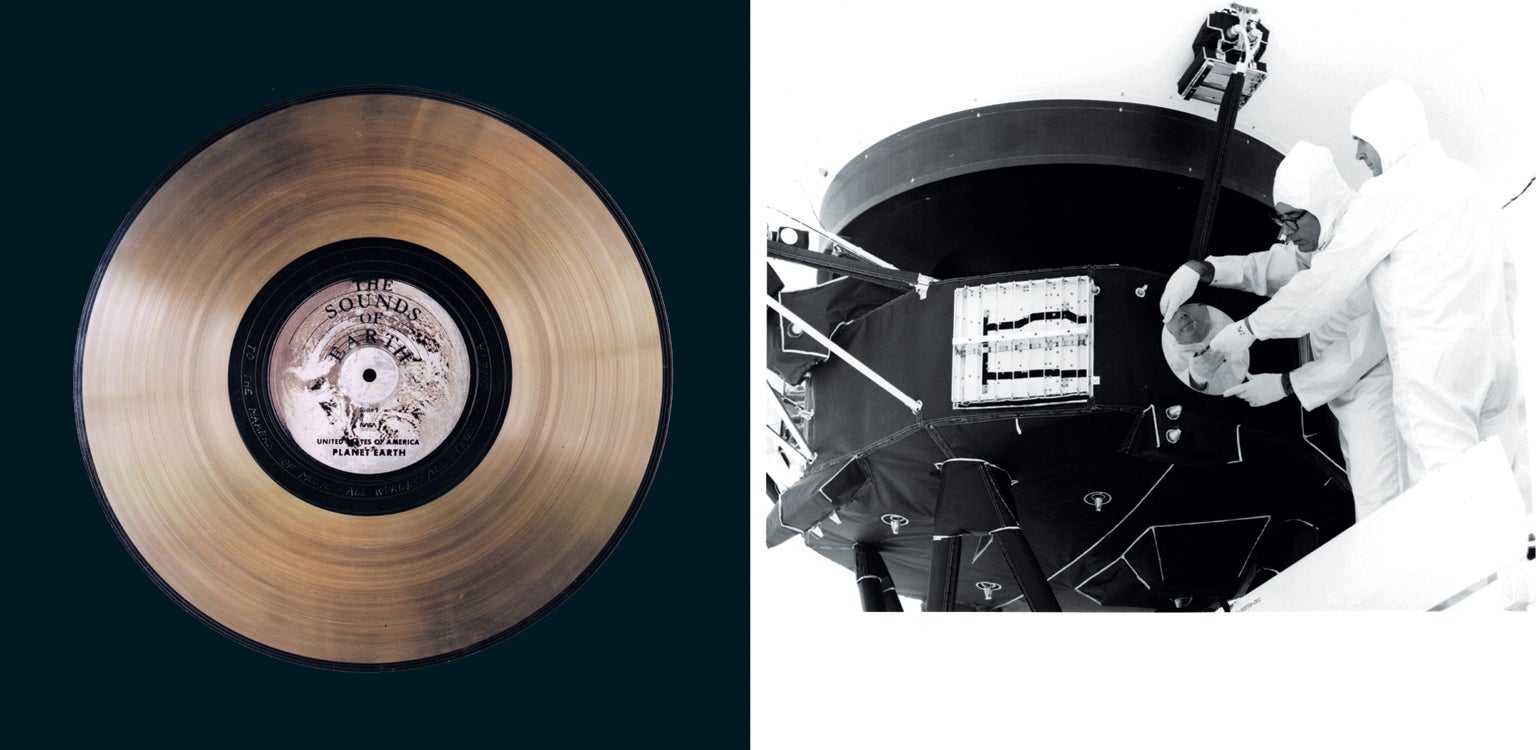 GOLDEN RECORD: Each Voyager carries a golden record (left) of sounds and images from Earth in case the spacecraft are intercepted by an extraterrestrial civilization. Engineers put the cap on Voyager 1’s record before its launch (right). Credit: NASA/JPL-Caltech
GOLDEN RECORD: Each Voyager carries a golden record (left) of sounds and images from Earth in case the spacecraft are intercepted by an extraterrestrial civilization. Engineers put the cap on Voyager 1’s record before its launch (right). Credit: NASA/JPL-Caltech
“In those days we always launched two spacecraft” because the failure rate was so high, said Donald Gurnett, only partly in jest. Gurnett, a physicist at the University of Iowa and one of the original scientists on the Voyager team, was a veteran of 40 other space missions. He spoke with me a few weeks before his death in January. (In an obituary, his daughter Christina said his only regret was that “he would not be around to see the next 10 years of data returning from Voyager.”)
When the Voyagers were being built, only one spacecraft had used a gravity assist to reach another planet—the Mariner 10 probe got one from Venus while en route to Mercury. But the Voyagers would be attempting multiple assists with margins of error measured in tens of minutes. Jupiter, their first stop, was about 10 times farther from Earth than Mercury. Moreover, the Voyagers would have to travel through the asteroid belt along the way. Before Voyager there had been a big debate about whether spacecraft could get through the asteroid belt “without being torn to pieces,” McNutt says. But in the early 1970s Pioneer 10 and 11 flew through it unscathed—the belt turned out to be mostly empty space—paving the way for Voyager, he says.
To handle all these challenges, the Voyagers, each about the size of an old Volkswagen Beetle, needed some onboard intelligence. So NASA’s engineers equipped the vehicles’ computers with 69 kilobytes of memory, less than a hundred thousandth the capacity of a typical smartphone. In fact, the smartphone comparison is not quite right. “The Voyager computers have less memory than the key fob that opens your car door,” Spilker says. All the data collected by the spacecraft instruments would be stored on eight-track tape recorders and then sent back to Earth by a 23-watt transmitter—about the power level of a refrigerator light bulb. To compensate for the weak transmitter, both Voyagers carry 12-foot-wide dish antennas to send and receive signals.
“It felt then like we were right on top of the technology,” says Alan Cummings, a physicist at Caltech and another Voyager OG. “I’ll tell you, what was amazing is how quickly that whole thing happened.” Within four years the MJS 77 team had built three spacecraft, including one full-scale functioning test model. The spacecraft were rechristened Voyager 1 and 2 a few months before launch.
Although many scientists have worked on the Voyagers over the decades, Cummings can make a unique claim. “I was the last person to touch the spacecraft before they launched,” he says. Cummings was responsible for two detectors designed to measure the flux of electrons and other charged particles when the Voyagers encountered the giant planets. Particles would pass through a small “window” in each detector that consisted of aluminum foil just three microns thick. Cummings worried that technicians working on the spacecraft might have accidentally dented or poked holes in the windows. “So they needed to be inspected right before launch,” he says. “Indeed, I found that one of them was a little bit loose.”
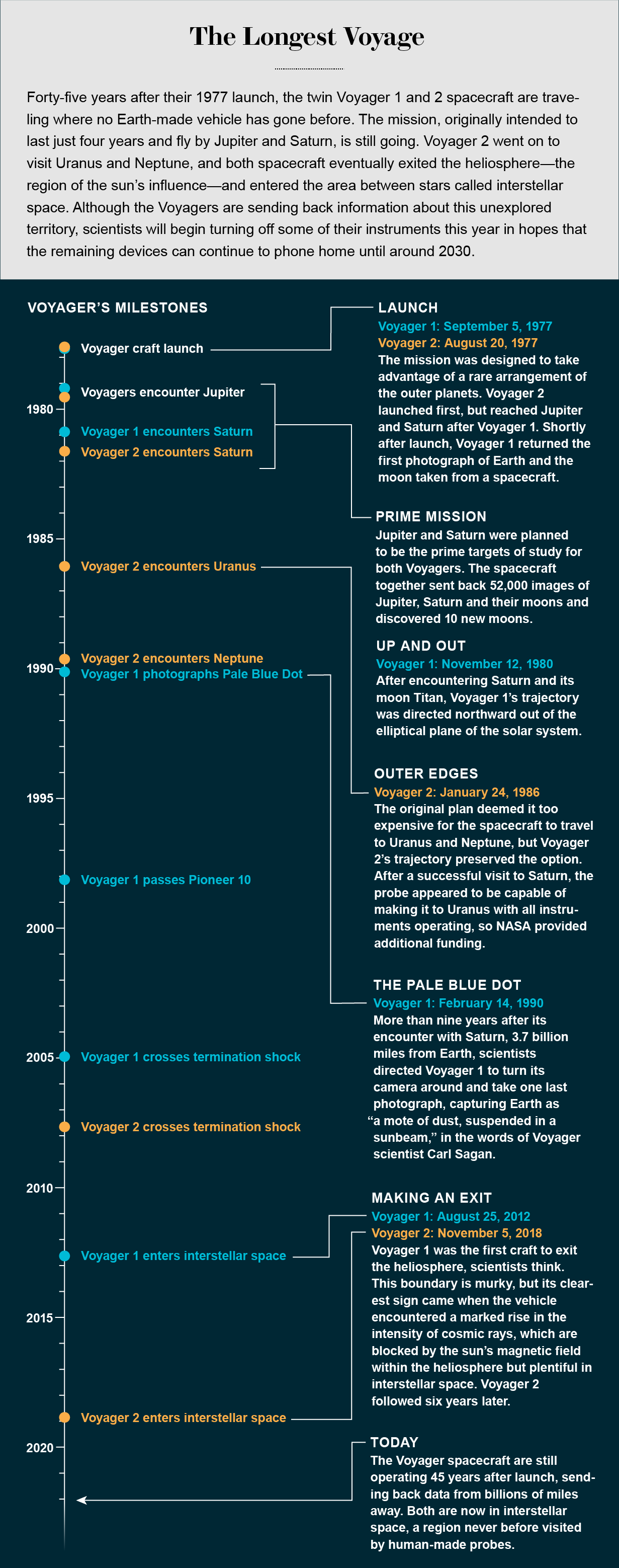
Credit: Graphic by Matthew Twombly and Juan Velasco (5W Infographic); Consultants: John Richardson (principal investigator, Voyager Plasma Science, Massachusetts Institute of Technology, Center for Space Research) and Merav Opher (professor, Department of Astronomy, Boston University)
Voyager 1 reached Jupiter in March 1979, 546 days after its launch. Voyager 2, following a different trajectory, arrived in July of that year. Both spacecraft were designed to be stable platforms for their vidicon cameras, which used red, green and blue filters to produce full-color images. They hardly spin at all as they speed through space—their rotational motion is more than 15 times slower than the crawl of a clock’s hour hand, minimizing the risk of blurred images. Standing-room crowds at JPL watched as the spacecraft started transmitting the first pictures of Jupiter while still about three or four months away from the planet.
“In all of the main conference rooms and in the hallways, they had these TV monitors set up,” Spilker says. “So as the data came down line by line, each picture would appear on a monitor. The growing anticipation and the expectation of what we were going to see when we got up really, really close—that was tremendously exciting.”
Cummings vividly recalls the day he caught his first glimpse of Jupiter’s third-largest moon, Io. “I was going over to a building on the Caltech campus where they were showing a livestream [of Voyager’s images],” he says. “I walk in, and there’s this big picture of Io, and it’s all orange and black. I thought, okay, the Caltech students had pulled a prank, and it’s a picture of a poorly made pizza.”
Io’s colorful appearance was completely unexpected. Before the Voyagers proved otherwise, the assumption had been that all moons in the solar system would be more or less alike—drab and cratered. No one anticipated the wild diversity of moonscapes the Voyagers would discover around Jupiter and Saturn.
The first hint that there might be more kinds of moons in the heavens than astronomers had dreamed of came while the Voyagers were still about a million miles from Jupiter. One of their instruments—the Low-Energy Charged Particle [LECP] detector system—picked up some unusual signals. “We started seeing oxygen and sulfur ions hitting the detector,” says Stamatios Krimigis, who designed the LECP and is now emeritus head of the space department at Johns Hopkins APL. The density of oxygen and sulfur ions had shot up by three orders of magnitude compared with the levels measured up to that point. At first, his team thought the instrument had malfunctioned. “We scrutinized the data,” Krimigis says, “but there was nothing wrong.”
The Voyagers’ cameras soon solved the mystery: Io had active volcanoes. The small world—it is slightly larger than Earth’s moon—is now known to be the most volcanically active body in the solar system. “The only active volcanoes we knew of at the time were on Earth,” says Edward Stone, who has been the project scientist for the Voyager missions since 1972. “And here suddenly was a moon that had 10 times as much volcanic activity as Earth.” Io’s colors—and the anomalous ions hitting Krimigis’s detector—came from elements blasted from the moon’s volcanoes. The largest of Io’s volcanoes, known as Pele, has blown out plumes 30 times the height of Mount Everest; debris from Pele covers an area about the size of France.
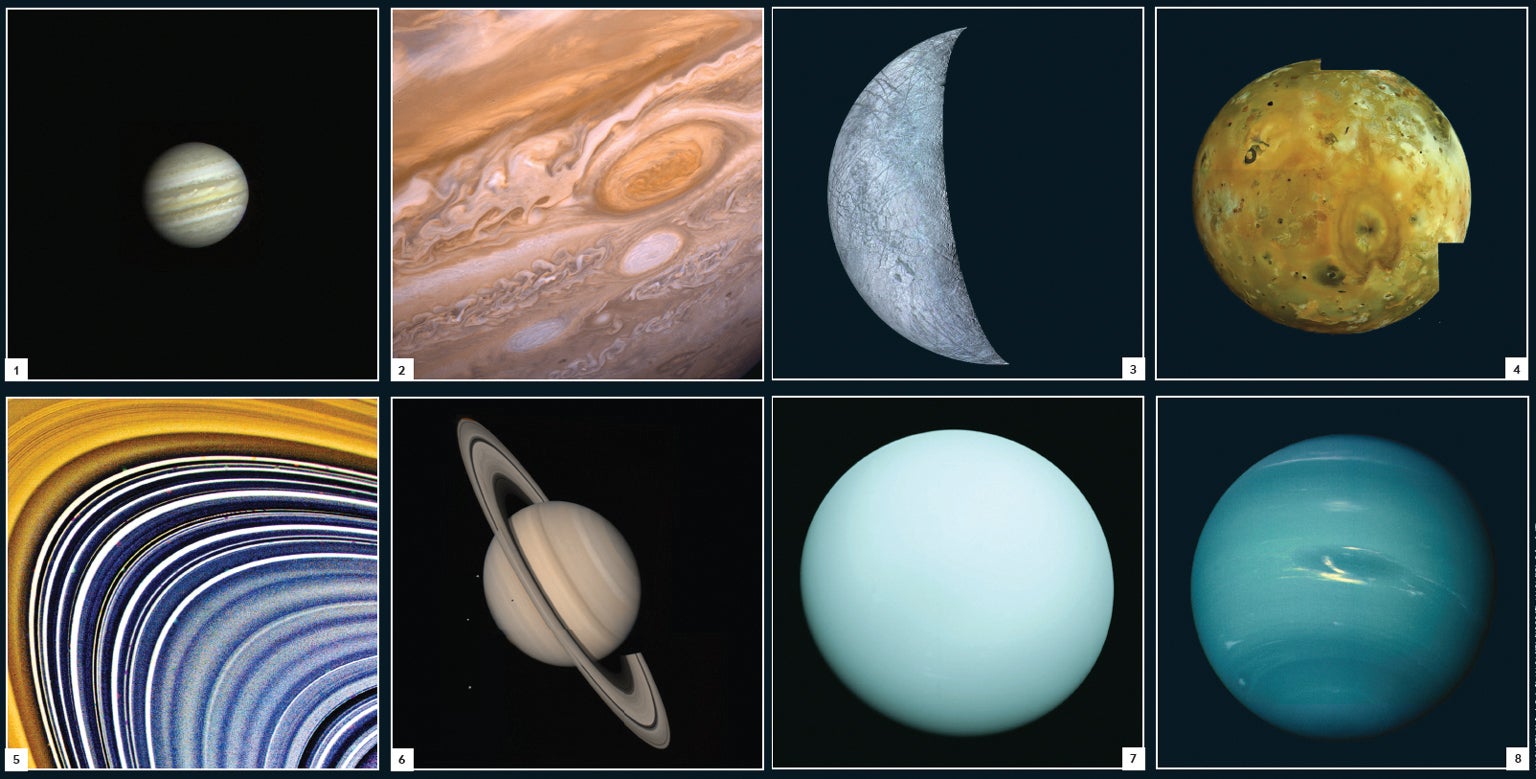 The twin spacecraft took a grand tour through the giant planets of the solar system, passing by Jupiter (1, 2) and Saturn (5, 6) and taking the first close-up views of those planets’ moons. Jupiter’s satellite Europa (3), for instance, turned out to be covered with ice, and its moon Io (4) was littered with volcanoes—discoveries that came as a surprise to scientists who had assumed the moons would be gray and crater-pocked like Earth’s. Voyager 2 went on to fly by Uranus (7) and Neptune (8), and it is still the only probe to have visited there. Credit: NASA/JPL (1, 2, 4, 5, 6, 8); NASA/JPL/USGS (3); NASA/JPL-Caltech (7)
The twin spacecraft took a grand tour through the giant planets of the solar system, passing by Jupiter (1, 2) and Saturn (5, 6) and taking the first close-up views of those planets’ moons. Jupiter’s satellite Europa (3), for instance, turned out to be covered with ice, and its moon Io (4) was littered with volcanoes—discoveries that came as a surprise to scientists who had assumed the moons would be gray and crater-pocked like Earth’s. Voyager 2 went on to fly by Uranus (7) and Neptune (8), and it is still the only probe to have visited there. Credit: NASA/JPL (1, 2, 4, 5, 6, 8); NASA/JPL/USGS (3); NASA/JPL-Caltech (7)
Altogether, the Voyagers took more than 33,000 photographs of Jupiter and its satellites. It felt like every image brought a new discovery: Jupiter had rings; Europa, one of Jupiter’s 53 named moons, was covered with a cracked icy crust now estimated to be more than 60 miles thick. As the spacecraft left the Jupiter system, they got a farewell kick of 35,700 miles per hour from a gravity assist. Without it they would not have been able to overcome the gravitational pull of the sun and reach interstellar space.
At Saturn, the Voyagers parted company. Voyager 1 hurtled through Saturn’s rings (taking thousands of hits from dust grains), flew past Titan, a moon shrouded in orange smog, and then headed “north” out of the plane of the planets. Voyager 2 continued alone to Uranus and Neptune. In 1986 Voyager 2 found 10 new moons around Uranus and added the planet to the growing list of ringed worlds. Just four days after Voyager 2’s closest approach to Uranus, however, its discoveries were overshadowed when the space shuttle Challenger exploded shortly after launch. All seven of Challenger‘s crew members were killed, including Christa McAuliffe, a high school teacher from New Hampshire who would have been the first civilian to travel into space.
Three years later, passing about 2,980 miles above Neptune’s azure methane atmosphere, Voyager 2 measured the highest wind speeds of any planet in the solar system: up to 1,000 mph. Neptune’s largest moon, Triton, was found to be one of the coldest places in the solar system, with a surface temperature of −391 degrees Fahrenheit (−235 degrees Celsius). Ice volcanoes on the moon spewed nitrogen gas and powdery particles five miles into its atmosphere.
Voyager 2’s images of Neptune and its moons would have been the last taken by either of the spacecraft had it not been for astronomer Carl Sagan, who was a member of the mission’s imaging team. With the Grand Tour officially completed, NASA planned to turn off the cameras on both probes. Although the mission had been extended with the hope that the Voyagers would make it to interstellar space—it had been officially renamed the Voyager Interstellar Mission—there would be no photo ops after Neptune, only the endless void and impossibly distant stars.
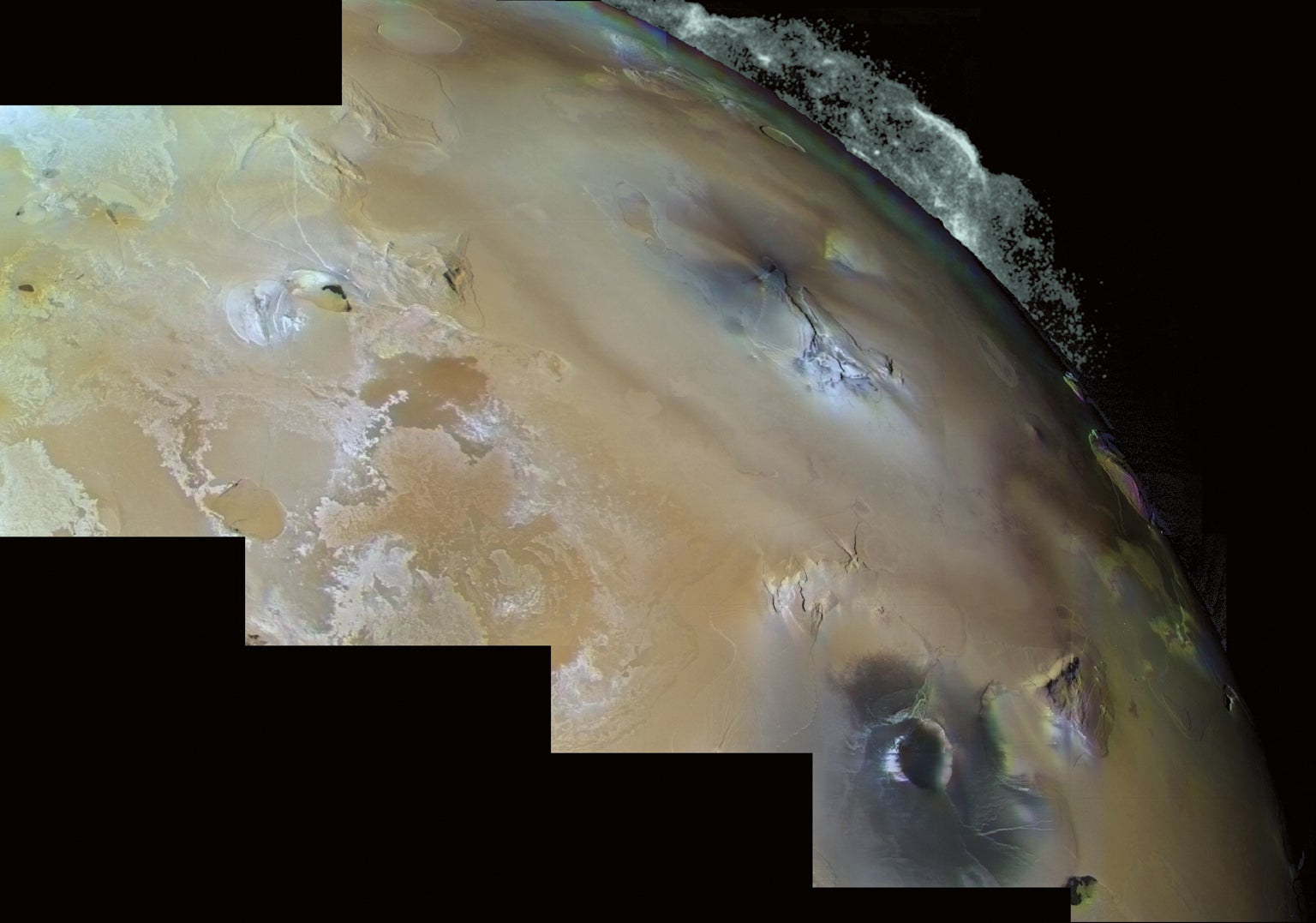 ERUPTION: The discovery of the volcano Pele, shown in this photograph from Voyager 1, confirmed that Jupiter’s moon hosts active volcanism. Credit: NASA/JPL/USGS
ERUPTION: The discovery of the volcano Pele, shown in this photograph from Voyager 1, confirmed that Jupiter’s moon hosts active volcanism. Credit: NASA/JPL/USGS
Sagan urged NASA officials to have Voyager 1 transmit one last series of images. So, on Valentine’s Day in 1990, the probe aimed its cameras back toward the inner solar system and took 60 final shots. The most haunting of them all, made famous by Sagan as the “Pale Blue Dot,” captured Earth from a distance of 3.8 billion miles. It remains the most distant portrait of our planet ever taken. Veiled by wan sunlight that reflected off the camera’s optics, Earth is barely visible in the image. It doesn’t occupy even a full pixel.
Sagan, who died in 1996, “worked really hard to convince NASA that it was worth looking back at ourselves,” Spilker says, “and seeing just how tiny that pale blue dot was.”
Both Voyagers are now so far from Earth that a one-way radio signal traveling at the speed of light takes almost 22 hours to reach Voyager 1 and just over 18 to catch up with Voyager 2. Every day they move away by another three to four light-seconds. Their only link to Earth is NASA’s Deep Space Network, a trio of tracking complexes spaced around the globe that enables uninterrupted communication with spacecraft as Earth rotates. As the Voyagers recede from us in space and time, their signals are becoming ever fainter. “Earth is a noisy place,” says Glen Nagle, outreach and communications manager at the Deep Space Network’s facility in Canberra, Australia. “Radios, televisions, cell phones—everything makes noise. And so it gets harder and harder to hear these tiny whispers from the spacecraft.”
Faint as they are, those whispers have upended astronomers’ expectations of what the Voyagers would find as they entered the interstellar phase of the mission. Stone and other Voyager scientists I spoke with cautioned me not to conflate the boundary of interstellar space with that of the solar system. The solar system includes the distant Oort cloud, a spherical collection of cometlike bodies bound by the sun’s gravity that may stretch halfway to the closest star. The Voyagers won’t reach its near edge for at least another 300 years. But interstellar space lies much closer at hand. It begins where a phenomenon called the solar wind ends.
Like all stars, the sun emits a constant flow of charged particles and magnetic fields—the solar wind. Moving at hypersonic speeds, the wind blows out from the sun like an inflating balloon, forming what astronomers call the heliosphere. As the solar wind billows into space, it pulls the sun’s magnetic field along for the ride. Eventually pressure from interstellar matter checks the heliosphere’s expansion, creating a boundary—preceded by an enormous shock front, the “termination shock”—with interstellar space. Before the Voyagers’ journeys, estimates of the distance to that boundary with interstellar space, known as the heliopause, varied wildly.
“Frankly, some of them were just guesses,” according to Gurnett. One early guesstimate located the heliopause as close as Jupiter. Gurnett’s own calculations, made in 1993, set the distance at anywhere from 116 to 177 astronomical units, or AU—about 25 times more distant. (One AU is the distance between Earth and the sun, equal to 93 million miles.) Those numbers, he says, were not very popular with his colleagues. By 1993 Voyager 1 already had 50 AU on its odometer. “If [the heliopause] was at 120 AU, that meant we had another 70 AU to go.” If Gurnett was right, the Voyagers, clipping along at about 3.5 AU a year, wouldn’t exit the heliosphere for at least another two decades.
That prediction raised troubling questions: would the Voyagers—or the support of Congress—last that long? The mission’s funding had been extended on the expectation that the spacecraft would cross the heliopause at about 50 AU. But the spacecraft left that milestone behind without finding any of the anticipated signs of interstellar transit. Astronomers had expected the Voyagers to detect a sudden surge in galactic cosmic rays—high-energy particles sprayed like shrapnel at nearly the speed of light from supernovae and other deep-space cataclysms. The vast magnetic cocoon formed by the heliosphere deflects most low-energy cosmic rays before they can reach the inner solar system. “[It] shields us from at least 75 percent of what’s out there,” Stone says.
The Voyager ground team was also waiting for the spacecraft to register a shift in the prevailing magnetic field. The interstellar magnetic field, thought to be generated by nearby stars and vast clouds of ionized gases, would presumably have a different orientation from the magnetic field of the heliosphere. But the Voyagers had detected no such change.
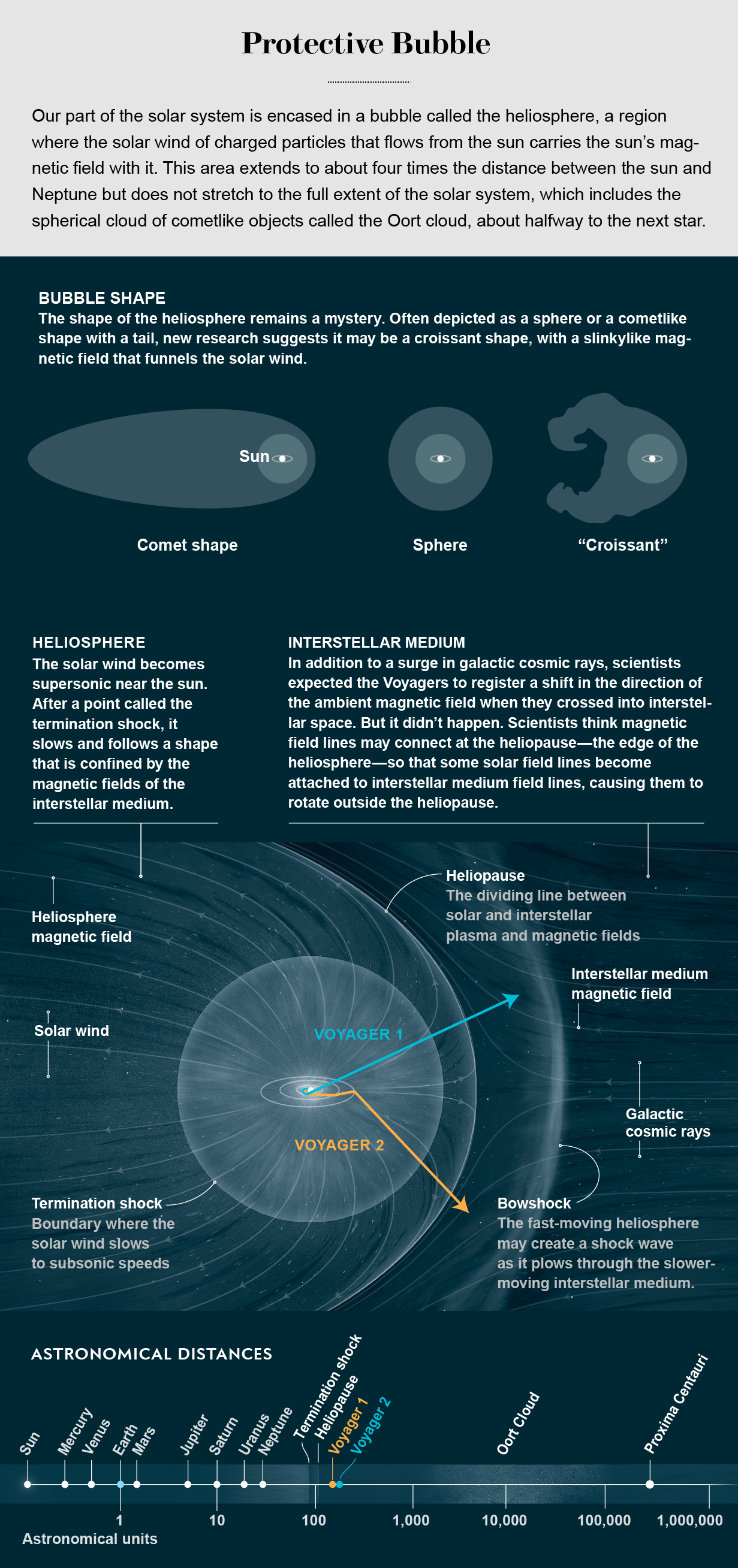
Credit: Graphic by Matthew Twombly and Juan Velasco (5W Infographic); Consultants: John Richardson (principal investigator, Voyager Plasma Science, Massachusetts Institute of Technology, Center for Space Research) and Merav Opher (professor, Department of Astronomy, Boston University)
Gurnett’s 1993 estimates were prescient. Almost 20 years passed before one of the Voyagers finally made it to the heliopause. During that time the mission narrowly survived threats to its funding, and the Voyager team shrank from hundreds of scientists and engineers to a few dozen close-knit lifers. Most of them remain on the job today. “When you have such a long-lived mission, you start to regard people like family,” Spilker says. “We had our kids around the same time. We’d take vacations together. We’re spanning multiple generations now, and some of the younger people on Voyager were not even born [when the spacecraft] launched.”
The tenacity and commitment of that band of brothers and sisters were rewarded on August 25, 2012, when Voyager 1 finally crossed the heliopause. But some of the data it returned were baffling. “We delayed announcing that we had reached interstellar space because we couldn’t come to an agreement on the fact,” Cummings says. “There was lots of debate for about a year.”
Although Voyager 1 had indeed found the expected jump in plasma density—its plasma-wave detector, an instrument designed by Gurnett, inferred an 80-fold increase—there was no sign of a change in the direction of the ambient magnetic field. If the vehicle had crossed from an area permeated by the sun’s magnetic field to a region where the magnetic field derived from other stars, shouldn’t that switch have been noticeable? “That was a shocker,” Cummings says. “And that still bothers me. But a lot of people are coming to grips with it.”
When Voyager 2 reached the interstellar shoreline in November 2018, it, too, failed to detect a magnetic field shift. And the spacecraft added yet another puzzle: it encountered the heliopause at 120 AU from Earth—the same distance marked by its twin six years earlier. That did not jibe with any theoretical models, all of which said the heliosphere should expand and contract in sync with the sun’s 11-year cycle. During that period the solar wind ebbs and surges. Voyager 2 arrived when the solar wind was peaking, which, if the models were correct, should have pushed the heliopause farther out than 120 AU. “It was unexpected by all the theorists,” Krimigis says. “I think the modeling, in terms of the findings of the Voyagers, has been found wanting.”
Now that the Voyagers are giving theorists some real field data, their models of the interaction between the heliosphere and the interstellar environment are becoming more complex. “The sort of general picture is that [our sun] emerged from a hot, ionized region” and entered a spotty, partly ionized area in the galaxy, says Gary Zank, an astrophysicist at the University of Alabama in Huntsville. The hot region likely formed in the aftermath of a supernova—some nearby ancient star, or perhaps a few, exploded at the end of its life and heated up the space, stripping electrons off their atoms in the process. The boundary around that region can be thought of as “kind of like the seashore, with all the water and the waves swirling and mixed up. We’re in that kind of turbulent region … magnetic fields get twisted up, turned around. It’s not like the smooth magnetic fields that theorists usually like to draw,” although the amount of turbulence seen can differ depending on the type of observation. The Voyagers’ data show little field variation at large scales but many small-scale fluctuations around the heliopause, caused by the heliosphere’s influence on the interstellar medium. At some point, it is thought, the spacecraft will leave those roiling shoals behind and at last encounter the unalloyed interstellar magnetic field.
Or maybe that picture is completely wrong. A few researchers believe that the Voyagers have not yet left the heliosphere. “There is no reason for the magnetic fields in the heliosphere and the interstellar medium to have exactly the same orientation,” says Len A. Fisk, a space plasma scientist at the University of Michigan and a former NASA administrator. For the past several years Fisk and George Gloeckler, a colleague at Michigan and a longtime Voyager mission scientist, have been working on a model of the heliosphere that pushes its edge out by another 40 AU.
Most people working in the field, however, have been convinced by the dramatic uptick in galactic cosmic rays and plasma density the Voyagers measured. “Given that,” Cummings says, “it’s very difficult to argue that we’re not really in interstellar space. But then again, it’s not like everything fits. That’s why we need an interstellar probe.”
McNutt has been pushing for such a mission for decades. He and his colleagues at Johns Hopkins recently completed a nearly 500-page report outlining plans for an interstellar probe that would launch in 2036 and potentially could reach the heliosphere within 15 years, shaving 20 years off Voyager 1’s flight time. And unlike the Voyager missions, the interstellar probe would be designed specifically to study the outer edge of the heliosphere and its environs. Within the next two years the National Academies of Sciences, Engineering, and Medicine will decide whether the mission should be one of NASA’s priorities for the next decade.
An interstellar probe could answer one of the most fundamental questions about the heliosphere. “If I’m looking from the outside, what the devil does this structure look like?” McNutt asks. “We really don’t know. It’s like trying to understand what a goldfish bowl looks like from the point of view of the goldfish. We [need to] be able to see the bowl from the outside.” In some models, as the heliosphere cruises along at 450,000 mph, interstellar matter flows smoothly past it, like water around the bow of a ship, resulting in an overall cometlike shape. One recent computer model, developed by astronomer Merav Opher and her colleagues at Boston University, predicts that more turbulent dynamics give the heliosphere a shape like a cosmic croissant.
“You can start multiple fights at any good science conference about that,” McNutt says, “but it’s going to take getting out there and actually making some measurements to be able to see what’s going on. It would be nice to know what the neighborhood looks like.”
Some things outlive their purpose—answering machines, VCRs, pennies. Not the Voyagers—they transcended theirs, using 50-year-old technology. “The amount of software on these instruments is slim to none,” Krimigis says. “There are no microprocessors—they didn’t exist!” The Voyagers’ designers could not rely on thousands of lines of code to help operate the spacecraft. “On the whole,” Krimigis says, “I think the mission lasted so long because almost everything was hardwired. Today’s engineers don’t know how to do this. I don’t know if it’s even possible to build such a simple spacecraft [now]. Voyager is the last of its kind.”
It won’t be easy to say goodbye to these trailblazing vehicles. “It’s hard to see it come to an end,” Cummings says. “But we did achieve something really amazing. It could have been that we never got to the heliopause, but we did.”
Voyager 2 now has five remaining functioning instruments, and Voyager 1 has four. All are powered by a device that converts heat from the radioactive decay of plutonium into electricity. But with the power output decreasing by about four watts a year, NASA has been forced into triage mode. Two years ago the mission’s engineers turned off the heater for the cosmic-ray detector, which had been crucial in determining the heliopause transit. Everyone expected the instrument to die.
“The temperature dropped like 60 or 70 degrees C, well outside any tested operating limits,” Spilker says, “and the instrument kept working. It was incredible.”
The last two Voyager instruments to turn off will probably be a magnetometer and the plasma science instrument. They are contained in the body of the spacecraft, where they are warmed by heat emitted from computers. The other instruments are suspended on a 43-foot-long fiberglass boom. “And so when you turn the heaters off,” Dodd says, “those instruments get very, very cold.”
How much longer might the Voyagers last? “If everything goes really well, maybe we can get the missions extended into the 2030s,” Spilker says. “It just depends on the power. That’s the limiting point.”
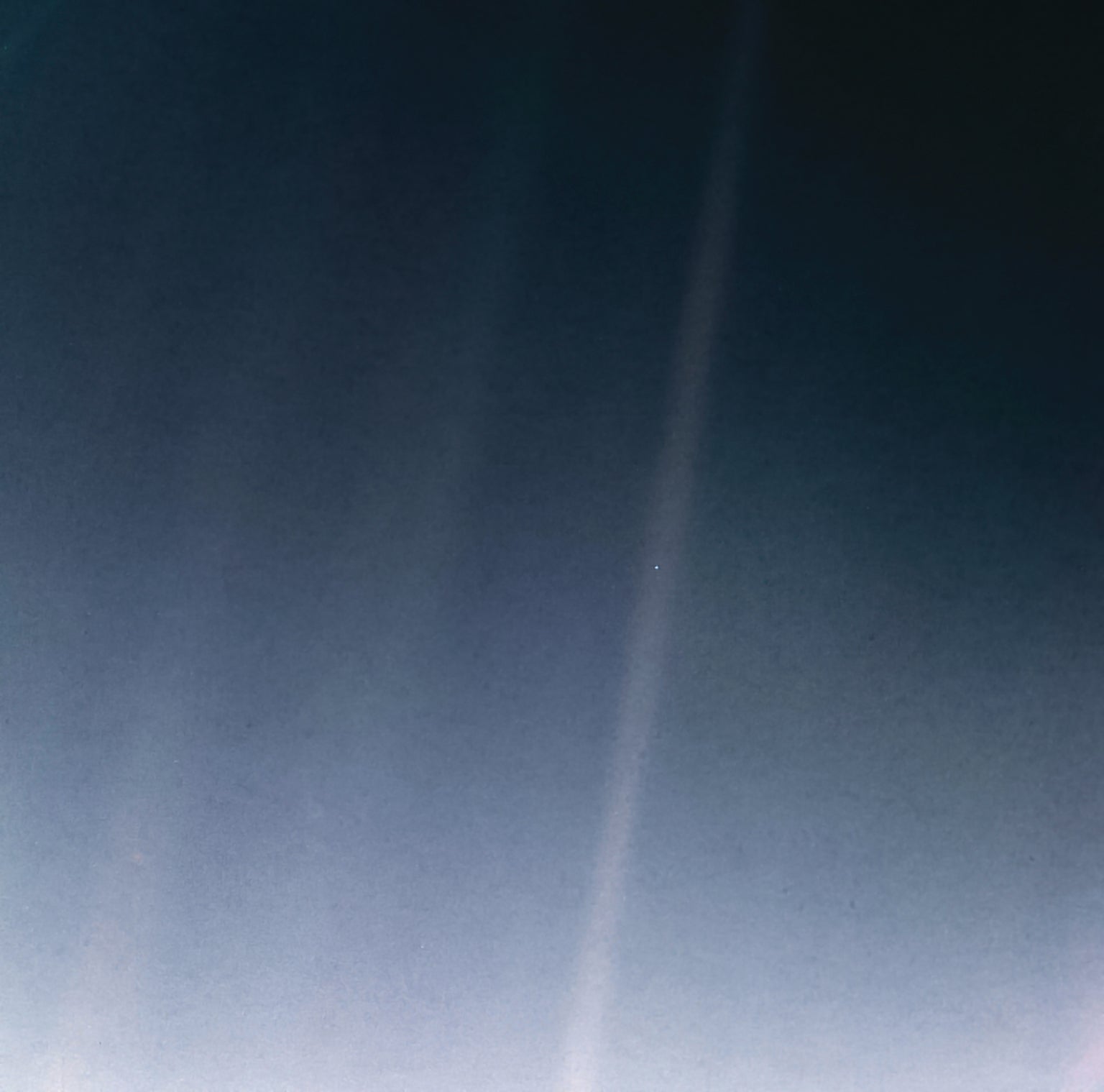 TINY SPECK: Among Voyager 1’s last photographs was this shot of Earth seen from 3.8 billion miles away, dubbed the “Pale Blue Dot” by Voyager scientist Carl Sagan. Credit: NASA/JPL-Caltech
TINY SPECK: Among Voyager 1’s last photographs was this shot of Earth seen from 3.8 billion miles away, dubbed the “Pale Blue Dot” by Voyager scientist Carl Sagan. Credit: NASA/JPL-Caltech
Even after the Voyagers are completely muted, their journeys will continue. In another 16,700 years, Voyager 1 will pass our nearest neighboring star, Proxima Centauri, followed 3,600 years later by Voyager 2. Then they will continue to circle the galaxy for millions of years. They will still be out there, more or less intact, eons after our sun has collapsed and the heliosphere is no more, not to mention one Pale Blue Dot. At some point in their travels, they may manage to convey a final message. It won’t be transmitted by radio, and if it’s received, the recipients won’t be human.
The message is carried on another kind of vintage technology: two records. Not your standard plastic version, though. These are made of copper, coated with gold and sealed in an aluminum cover. Encoded in the grooves of the Golden Records, as they are called, are images and sounds meant to give some sense of the world the Voyagers came from. There are pictures of children, dolphins, dancers and sunsets; the sounds of crickets, falling rain and a mother kissing her child; and 90 minutes of music, including Bach’s Brandenburg Concerto No. 2 and Chuck Berry’s “Johnny B. Goode.”
And there is a message from Jimmy Carter, who was the U.S. president when the Voyagers were launched. “We cast this message into the cosmos,” it reads in part. “We hope someday, having solved the problems we face, to join a community of galactic civilizations. This record represents our hope and our determination, and our good will in a vast and awesome universe.”

